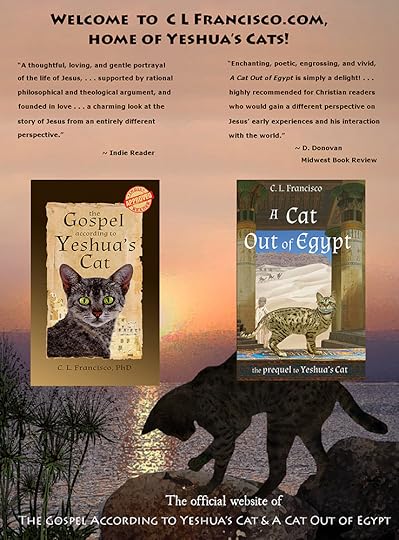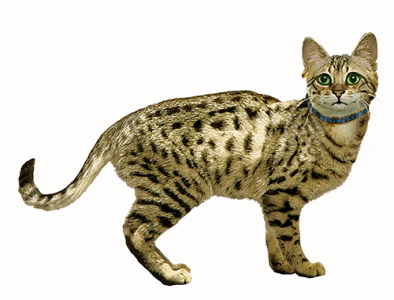The Temple of Bast at Bubastis
A number of early readers of A Cat Out of Egypt have expressed an interest in learning more about the ancient temple of Bast/Bastet at Bubastis. They are readers after my own heart–if you don’t try to understand the world a character lives in, you have little chance of understanding who that person is. Ancient Egypt is a truly an alien land for English-speaking people of the contemporary Western world–thus ACOOE’s many detailed descriptions of ancient Egyptian customs. I hope you find their culture as fascinating as I did!
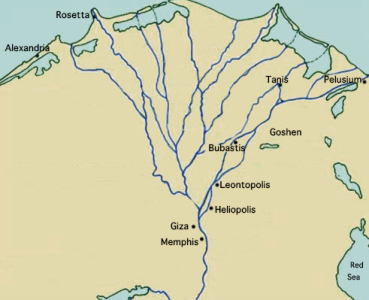 When I decided to feature an Egyptian temple cat as Yeshua’s childhood companion, I chose Bubastis for three reasons: first, because it was a temple dedicated to the cat goddess Bast/Bastet; second, because a description of the temple in the mid 5th C BCE has come down to us in the writings of the historian Herodotus; and third, because Bubastis lies in the general area of the Nile Delta where many Jewish settlements existed in the 1st C CE, which made it a likely location for Yeshua’s family.
When I decided to feature an Egyptian temple cat as Yeshua’s childhood companion, I chose Bubastis for three reasons: first, because it was a temple dedicated to the cat goddess Bast/Bastet; second, because a description of the temple in the mid 5th C BCE has come down to us in the writings of the historian Herodotus; and third, because Bubastis lies in the general area of the Nile Delta where many Jewish settlements existed in the 1st C CE, which made it a likely location for Yeshua’s family.
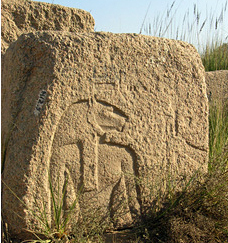
Bast relief from Bubastis
I decided to refer to the Egyptian goddess Bast/Bastet as “Bast,” rather than “Bastet,” because I wanted to call to mind her earlier persona as a lion goddess. She was usually called “Bastet” by Yeshua’s time, a diminutive form of her original name “Bast,” emphasizing her less threatening aspect as a domestic cat. But she never lost the connection to her earlier self–a self capable of terrifying rage, who stood between the forces of chaos and the sun’s daily rising, as well representing the more fertile and nurturing aspects of a great lioness.
The major construction periods that archaeologists have been able to identify at Bubastis begin with the Middle Kingdom (roughly 2000 BCE) through in the Hyksos dynasty in the mid-to-late second millennium BCE. The entrance hall, festival hall, and hypostyle hall were all likely to have been built during those years, probably replacing earlier structures. Invading Persian forces in the 6th C BCE inflicted heavy damage on many Egyptian temples, including Bubastis. The repairs and new construction undertaken during the 30th Dynasty (Nectanebo and others) were probably made necessary by this destruction.
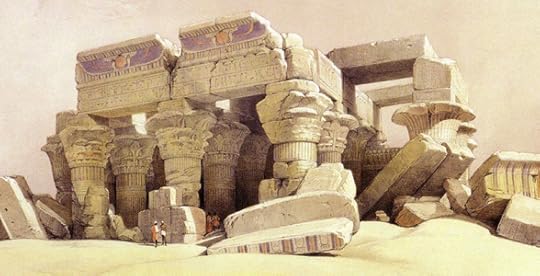
“Kom Ombo,” Roberts
Here is a passage describing the temple at Bubastis as Herodotus experienced it around 450 BCE, a hundred years before the addition of the sanctuary hall by Pharaoh Nectanebo:
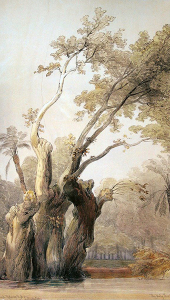
“Holy Tree,” David Roberts
Save for the entrance, it stands on an island; two separate channels approach it from the Nile, running in contrary directions as far as the entry of the temple; each of them is a hundred feet wide and overshadowed by trees.
The outer court has a height of 60 feet, and is adorned with notable tall figures. The temple is in the midst of the city, the whole circuit of which commands a view down into it; for the city’s level has been raised, but that of the temple has been left as it was, so that it can be seen into from without.
A stone wall runs around it; within it is a grove of very tall trees growing around a great shrine wherein is the image of the goddess; the temple is a square, each side measuring an eighth of a mile. A paved road of almost a half mile’s length leads to the entrance, running eastwards toward the marketplace; this road is about 400 feet wide, and bordered by trees reaching to heaven.
.
Unfortunately, like many 19th C efforts, the first major excavation at Bubastis by Edouard Naville was not systematically done–although even then the temple was little more than a field of uneven ground, suggesting the scattered and fallen remains buried beneath the surface. In the photo below you can see clearly the raised ground of the city surrounding the temple area as Herodotus described it . The people of the Nile delta made a habit of building up the mounds upon which their towns and cities were built to keep them above the level of the Nile floods.
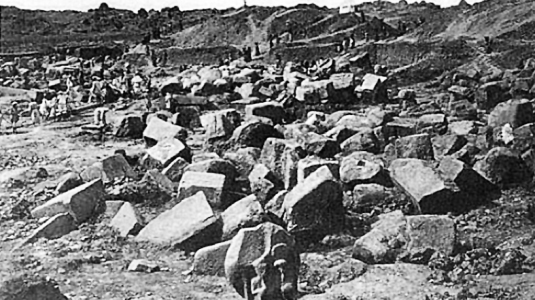
Naville’s Excavation, 1887-1889
Major artifacts from Bubastis were carried away to Western museums with little regard for their original placement. Many lesser objects were simply cast aside, leaving them vulnerable to theft and weathering. Recent scholars have struggled to piece together the temple’s appearance, both before and after Nectanebo’s changes (350 BCE). Most agree that his major contribution was a new sanctuary area, probably replacing an old one, at the western end of the temple.
The map below reflects a likely plan of the temple area at the time of the Roman conquest of Egypt (30 BCE):
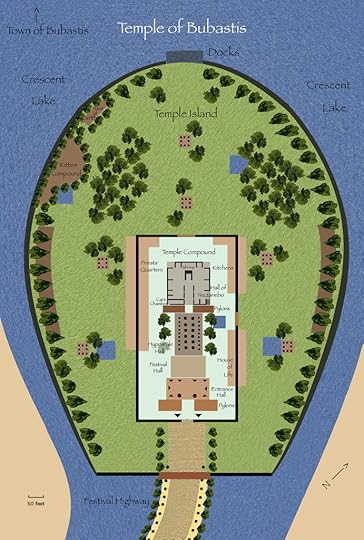
Temple of Bast at Bubastis, map by C.L. Francisco
The festival road, probably lined with sphinxes, approached the temple from east, where it entered the towering pylons that formed the temple’s main gate.
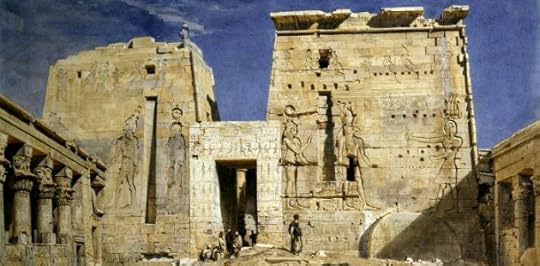
Similar pylons at temple of Isis, Philae
In front of the pylons, two matching granite statues of a Hyksos king (1500 BCE, below) guarded the approach to the temple. Two columns with palm-leaf capitals stood within the gate, which opened into the entrance hall. The entrance hall itself apparently had no columns, much of its space being filled with statues of various pharaohs, including two monumental statues of Ramesses II standing against the inner wall of the pylons. Both the entrance hall, and the so-called festival hall, possibly a festival monument honoring Osorkon II (9th C BCE), were probably built by Osorkon I and/or Osorkon II.
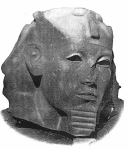

Beyond the festival hall was the great hall of columns, or hypostyle hall. The hypostyle hall may have been partially divided into two different segments, but the chaos of the fallen columns makes it difficult to say with any certainty.
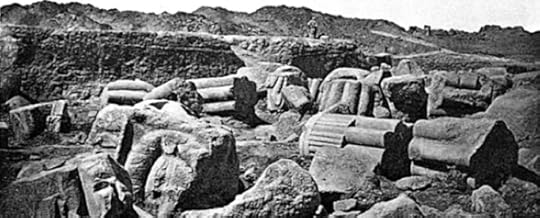
Fallen columns at Bubastis
Scholars also disagree as to whether the hall of columns had a ceiling or only epistyles connecting and securing the columns along their tops. There were certainly two types of granite columns discovered–a smaller set with Hathor-head capitals, and a larger set with palm leaf and lotus bud/papyrus capitals.



At the very western end stood Nectanebo’s 4th C BCE sanctuary hall, entered through a second pair of pylons. The sanctuary hall contained the large central shrine of the goddess, as well as 7 – 12 smaller shrines along the side and back walls, dedicated to other deities. Most of the sanctuary hall was built of red granite, with floors of basalt. The walls, doors, and ceilings were ornately carved, as was the shrine of the goddess. Stars covered the ceilings.
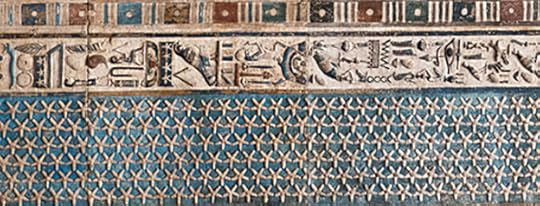
Starry sky, Hathor temple ceiling, Dendera
The goddess’ shrine, or naos, was carved from a single piece of red granite, approximately 12 feet high and 5 feet wide, with gilded wooden doors opening inward. Based on its available interior space, the goddess’ statue within the naos would have been 4 – 4 ½ feet high. The image would certainly have been overlaid with gold, if not made of solid gold, with decorations of precious stones, turquoise, and lapis lazuli.
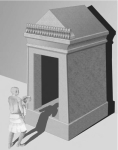

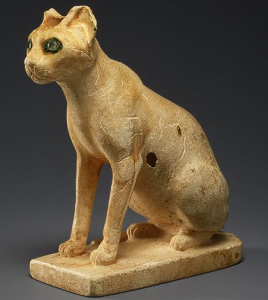
Bast ointment jar
Since the map above was created to illustrate the temple as it was described in A Cat Out of Egypt, the chamber of the Great Cat is shown on the map. In reality, there was no such chamber, so far as anyone knows, just as there was probably no Great Cat. But there was a House of Life, as well as gardens, pools, and probably small free-standing temple buildings. Every temple also had its practical buildings, including housing, kitchens, laundries, animal areas, and temple workshops. Bubastis was known for the ointments and perfumes created by its staff as an expression of the goddess’ reputation as Lady of the Ointment Jar, and Mistress of the Embalming House. The temple at Bubastis was also renowned for the oracle of the goddess.
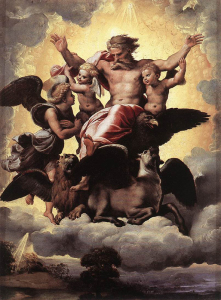
“Ezekiel’s Vision”
Bubastis even appears in the writings of the Prophet Ezekiel (Ezek 30:17), when he warns various nations of the wrath to come : “The young men of On and Pi-beseth (Bubastis) shall fall by the sword, and the cities themselves shall go into captivity.” Scholars have speculated that the revels accompanying the annual temple festival at Bubastis may have been responsible for Bubastis’ licentious reputation. Herodotus describes the festival briefly below:
The manner observed in the festival of Bubastis is this: men and women embark promiscuously in great numbers, and during the voyage, some of the women beat upon a tabor, while part of the men play on the pipe, the rest of both sexes singing and striking their hands together at the same time. At every city they find in their passage they bring the boat to land, and some of the women continue their music, but some of the others either provoke the women of the place with opprobrious language, or dance, or draw up their garments; and they do this at every town that stands by the shore. When they arrive at Bubastis, they celebrate the festival with numerous sacrifices, and consume more wine than in all the rest of the year. For the inhabitants say this assembly usually consists of about 700,000 men and women, besides children.
The feline narrator of A Cat Out of Egypt has her own ideas about the festival.
.
.

